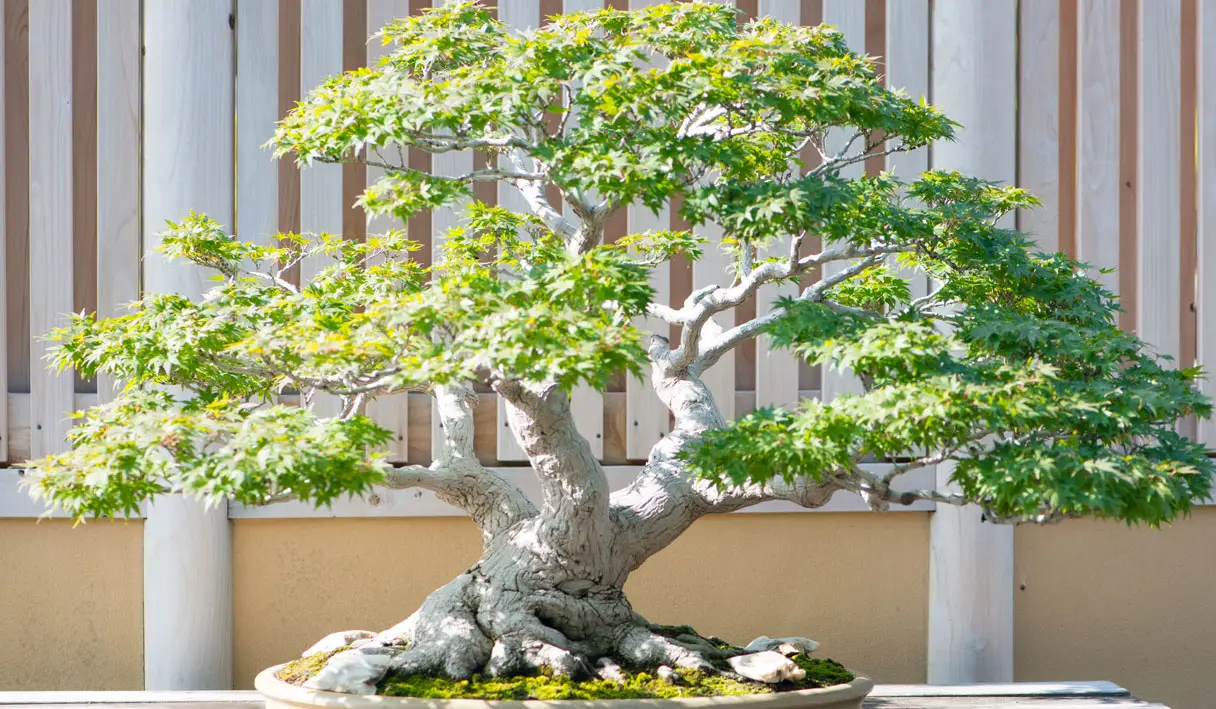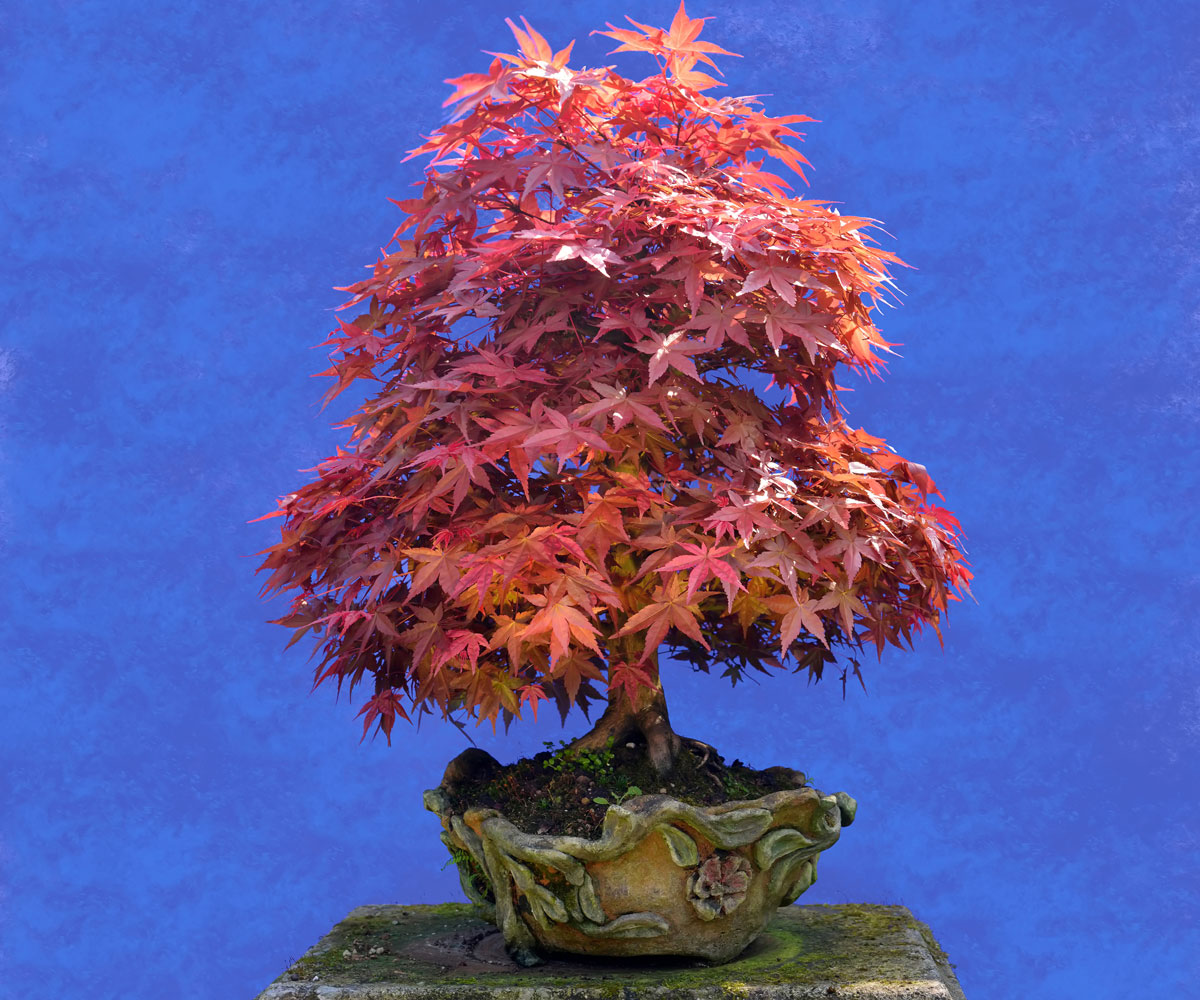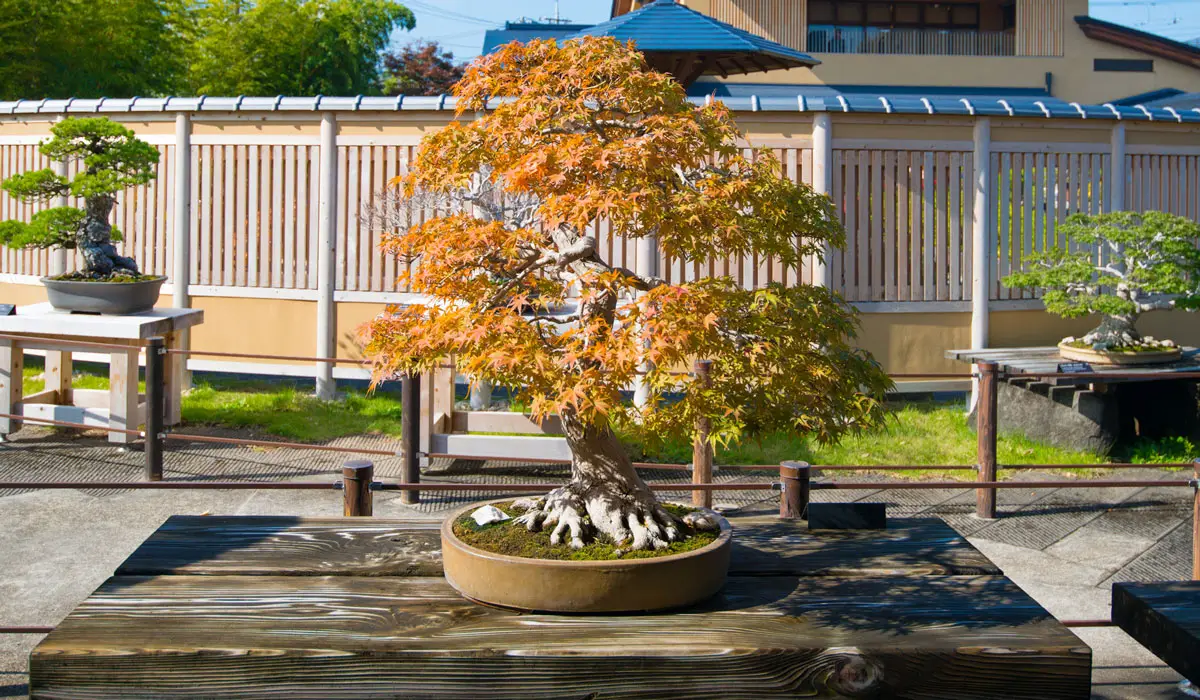Can You Grow a Maple Tree as a Bonsai?

This post follows our research editorial guidelines.

The ancient art of bonsai refers to a specific way gardeners grow and prune a variety of trees to achieve a specific aesthetic. It’s understandable that many gardeners would want to bring the common beauty of the Japanese maple tree to bonsai form, but can you grow a maple tree as a bonsai? Yes! Japanese maple trees, with their vibrant fall colors and easy care requirements, are a popular and rewarding bonsai choice for all levels of gardeners.

Table of Contents
How do you Care for a Maple Bonsai Tree?
Japanese maple bonsai need similar care as most maple trees: the right amount of sun, adequate water, and good drainage. But, since bonsai trees need specific care to achieve a precise look, extra light, water, soil, and of course pruning, is essential. With so much to know about how bonsai thrive in a variety of conditions, here are a few general rules to follow:
Watering
As with most maple trees, Japanese maple bonsai need regular watering and misting to produce new growth. Depending on the location of your bonsai tree, you may need to water and mist daily if the soil drys quickly. But why water and mist? Simply put, in the absence of rain, the branches and leaves on your tree require it. When watering just the root of your tree, it may take time for the moisture to reach the branches and leaves, especially during the summer. Misting the leaves and watering the roots ensures that all areas of your tree get adequate moisture.
If your pot is outside, I recommend stationing the spray hose next to your tree with the mist setting on. For hot, dry days, you can leave the water on for up to an hour to give the tree adequate moisture. If your pot is indoors, spraying your tree’s leaves at least every other day will keep your tree happy when humidity levels are low.
“In the summer, bonsai need cool nights, sunny days, and mist or rain almost daily. If your climate does not offer these conditions naturally, you must supply them.” writes Diane Relf, Extension Specialist, Horticulture, Virginia Tech University. Relf continues, “placing bonsai on a slatted stand in the garden is a good way to keep drainage conditions optimum.”
If grown indoors, remember that the conditions inside your home vary and heating and cooling systems reduce the humidity in the air. Misting the leaves of the tree as well as watering the root of the bonsai will help the plant thrive.
Soil and pot use

Bonsais are as known for their unique shape as they are for the ornate and distinctive look of the bonsai pot. To achieve the bonsai aesthetic, look for a wide, short pot like the one pictured above. While the look you choose is up to you, I recommend contrasting the shape of the tree with the shape of the pot. For example, if the trunk of your tree curves, balance the aesthetic with a square-shaped pot. Besides the shape, choosing the right element is important. Traditional bonsai trees are planted in either ceramic or clay pots; although plastic bonsai pots are common, if sticking to tradition is important to you, finding a clay or ceramic pot at a local garden centre is easy enough to do.
While maple trees are adept at growing in a variety of soil conditions, maple trees grown as bonsai have specific soil needs. I recommend starting with soil that provides good absorption, drainage, and aeration. I recommend using bonsai soil that is developed with the bonsai’s unique needs in mind. This should be available and easy to find at most garden centres.
Your Japanese maple has a strong, robust root system that doesn’t want to sit in water or search for its moisture, so providing the right balance will ensure it gets exactly what it needs.
Light
As with any maple tree, Japanese maples thrive best in the morning sun or dappled south-facing light where they avoid the harsh afternoon rays. Finding sunny south-east facing corner in your yard or patio to place your Japanese maple bonsai on is best. If your climate is mild, however, and you lack an east-facing location, your maple tree should still do well as long as you don’t let it dry out. Wherever you choose to place your tree, pay close attention to how much direct sun the maple tree is getting. While a bright location is the best, too much direct sun whether morning, full day or afternoon, can impact the health of your bonsai.
Pruning
Many savvy gardeners eager to create the ideal bonsai look find the pruning stage to be the most rewarding part of the experience. If you have a creative mind, manipulating the plant growth through pruning and wiring allows for that creative spirit to shine and can provide you with hours of entertainment. Be careful while pruning that you use the right sheers (sharp, clean, and curved are best) and that you follow care instructions.
- Perform regular maintenance pruning throughout the year. Start by pinching off new growth in early spring and trimming back branches that have grown leggy. By pruning unwanted branches or dead leaves off of your bonsai, you’ll be able to get the look and shape of the tree you’re after.
- Structure pruning will further help you meet the shape of the tree by removing large branches from the tree. Bonsai are meant to mimic the look and shape of full-grown trees occurring in nature. Look at the trees outside and how they’re shaped and formed by imperfect light or wind conditions. Your bonsai should resemble that unpredictable growth.
Note that the best time to structure prune is in early spring or late autumn, outside of the growing period.
Pests
While not common, spider mites, aphids, and other common house pests do find a home on maple bonsai trees from time to time. Before you head out to find an expensive insect repellent or pest control, add 2-3 drops of liquid dish soap in a spray bottle with 30 oz of water then mist your tree each day. Within a few days to a week, you should notice a significant improvement in your plant. If you’re still finding a few stubborn insects on your leaves or trunk, take a damp cloth and wipe them off. You may also pour the same diluted soapy mixture right into the soil to kill any left-behind bugs taking shelter in the cool dirt.
How fast do Japanese Maple Trees Grow?

Performing the above tasks should keep your Japanese maple bonsai happy and shaping into a beautiful bonsai plant, but how quickly do the trees grow, exactly? Japanese maple bonsai, known for its slow growth habit, will take time to establish, growing at a rate of 12 to 24 inches per year. While an impatient gardener may want a large tree sooner, the slow-growth habit is ideal for bonsai.
Can I Grow A Japanese Bonsai Indoors?
Yes! All bonsai, including Japanese maple bonsai, do well either indoors or outdoors, as long as the temperature and water conditions are right. For any Japanese maple tree grown indoors, there are specific requirements to help it through the winter dormancy phase. For more information, check out how to grow a maple tree indoors.
How Often Should I Water Or Mist My Bonsai?
Watering and misting should occur daily, especially during the summer growing season. Maple trees don’t like to sit in wet roots at night, so plan to water your tree each morning with a gentle misting in the afternoon sun to keep the leaves cool. If you live in a cooler climate with more moderate daytime summer highs, it’s fine to go a day or two between watering. But, if the sun is high in the sky, it’s crucial to water at least three times per week.
Final Thoughts
If you’re looking for a distinct-looking potted plant, then a Japanese maple bonsai is the plant for you. As a relatively low-maintenance tree, gardeners of any level find growing Japanese maple bonsai a great first choice. Additionally, with its stunning fall colours and the curvy shape of the trunk, a Japanese maple bonsai provides annual interest to any landscape or home. Given the right conditions and care, the Japanese maple bonsai will act as a centerpiece to any yard or home, providing you with years of enjoyment as you prune, shape, and fuss over your bonsai.
